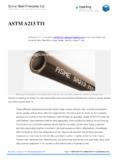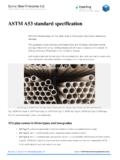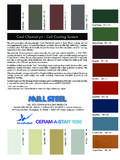Transcription of In Ground Pool Installation guide, revised. - Family …
1 In Ground Pool Installation guide General Information for Installing an In Ground Swimming steel Wall Pool Disclaimer: This Installation Booklet is to be used ONLY as a basic guide and information on the Installation of an inground steel wall vinyl liner swimming pool. There are multiple construction methods and techniques that can be used in the construction of an inground swimming pool. In addition, the construction of an inground swimming pool must comply with all local / state / and National Codes (such as the Virginia Baker Graeme Act). Before construction begins, you must verify all applicable building permits. Due to the various contingencies, and issues that can arise in the construction process, it is highly recommended that a local swimming pool professional install all swimming pools. It is highly recommended that all Residential Swimming pools be constructed without a diving board and slide; and users of the swimming pool be required to only enter a pool feet first.
2 ALL SAFETY SIGNAGE that is provide with all components and products from manufactures must be installed in accordance with the instruction provided by each manufacturer. In addition to the information in this booklet, the internet is another good source for further information regarding the construction of swimming pools, swimming pool safety, and swimming pool products and Installation techniques, problems and solutions. You should also review the following web sites and , for additional information. General Information Planning Stage: - Refer to the local building codes. The codes will provide you with the easements, set backs and general requirements for positioning the pool and the size and shape that will best fit in your yard. Also, your local code enforcement may be able to help with plot plan and any obstructions that may be in yard - Contact your local utilities companies in reference to underground utilities (Communication, gas, electric, etc.)
3 - Obtain proper permits, fencing requirements that are required - Contract any professionals that may be needed, gas, electrical etc. Pool Size and Shape: - Try to optimize the yard space and bather loads to consider the size of pool. Remember that you will want a deck around pool - Keep the pool within close proximity of the home if possible, for rest rooms, food etc. - The sun is an important factor as well, the more the pool is in the sun the warmer the water - Avoid trees near the pool. - The closer the pool is to electrical service the less it cost to run the wires. Terms: - Liner, this is the waterproof membrane that is inside the pool and is the surface after it is filled( like the sheet rock inside a house). - Walls or Panels, these are the structure of the pool, (like the 2x4 in a house). - Steps, built into the structure that enable ingress and egress for the inside of the pool - Coping, this is the top perimeter of the pool, it acts as both a trim for the deck and also to hold the liner in place - Main Drain, This is a suction device that goes in the deep end of a pool and is used for circulate water to the pump.
4 Check codes - Skimmer, this is a device that circulates water from surface of the pool. Rule is 1. skimmer for 400 square feet. - Returns, these are what bring water back to the pools via the pump. The water that is returned to the pool has been through the filter and heater. - Lights, underwater lights come in different configuration check codes for proper lighting - Hand Rails, used in conjunction with steps and ladders to aid in ingress and egress for the pool. - Pump, used to circulate water from pool through filter and back to pools - Filter, cleans the water using different types of media ,sand, DE or cartridge Tools Needed: -Marking spray paint, for layout -Wrenches, for use during assembly of the wall system -Socket set, for assembly of wall system -Screwdriver, flat and Philips heads, for use in assembly of steps and plumbing fittings -Tape Measures, two needed, a 25' and a 100' Used for layout, squaring the pool etc -Utility knife, used to cut liner for assembly of plumbing fittings and steps -String Line, used for layout, excavation and bottom layout, bright color helps -Drill with a variety of bits, used to attach coping, drill return holes - 3 whole saw, used in drilling the return holes in panels -Wheelbarrow, used to move dirt -Shovels, both flat and round, trending, shaping etc.
5 - Rakes, used to shaping the pole interior -Transit, for layout, excavation and leveling of the pool (rental). -Pick Axe, for shaping the dig -Cement mixer, paddle style for mixing pool base material -Hammers, sledge and standard, for driving stakes -Tamper, used to smooth the bottom material -Hacksaw with metal blade, used to cut PVC pipe and aluminum coping -Trowels (mags and finish), used to form base material (rental). - Carpenter square, for layout -Large channel locks, for tightening of plumbing fittings -Level, 4' long for checking step level and set up -Shop vacuum, for cleaning and seating liner (may need two). -Broom, for cleaning and seating liner -Garden hose, for the fill and mixing base material - C clamps, large ones for step set up (can use welders clamps). -Duct Tape, good quality for panel joints - Wood, assorted 2x4, stakes for set up and pool layout -Nails, to be used for setup -Temporary Fence, used during the build process as a barrier to the build site Excavation Equipment: Excavator or Backhoe- Recommend and experienced excavator operator Bobcat Dump truck Pool Layout and Location Location: - Review the local building codes for setback, easements, variances and utilities (call utility companies).
6 - Look for flat, drainage away from pool is needed, a clear area this will reduce costs - Have a wide access area for excavation equipment - Look for sunny area, with no or limited trees - Look at prevailing wind for skimmer and return locations - Position pool to be near rest rooms - Position pool to be close to electrical supply, will help reduce cost - Make sure that pool will not be built on fill dirt RECTANGLE POOL: -When lying out pool please be advised that the excavation will have an over dig , the over dig is typically 30 larger then the pool on each side, and will enable you to work on the back side of the pool with ample room. The over dig is an extension of the shelf. The shelf is what the panels rest. Note: the over dig may vary based on pool wall and brace combination Over dig is typically 24 to 36 greater the pool size For example: a 14' x 28' rectangle pool will have an excavation of ' x '. 16' x 32' rectangle pool will have an excavation of ' x '.
7 18' x 36' rectangle pool will have an excavation of ' x '. Note: Always square the dig layout. If the pool has a step, take the position of the step and add extra excavation area for the steps. Drive Stakes in Ground to form the box, use a bright marker paint to show lines of pool on Ground Typical Layout RADIUS POOLS AND OVALS: -There are many ways to layout radius pools. One of the easiest is to form a box of the maximum length and width of the pool and place a stake at the four points. -Using two long tape measures you can triangulate the center points of the radii. You must have large space to swing . -Then drive a stake at the radii center point and swing the arcs. You can initially use baking flour to mark Ground so it may be easily changed prior to using the more permanent marker paint. Note: Always check dimensions prior to starting excavation STEPS: - If the pools will to have a step, add area to the layout to allow for a step. Steps vary in size and shape.
8 An 8'wide straight step, is typically 4' deep: you will need to over dig 24 around step, or 12' wide by 6' deep over dig ELEVATION. Elevation is a very important part of the pool layout. The pool should be 6-12 higher then existing grade. You want any drainage away from pool, BUT, also not have drainage towards the house or other critical areas. -The elevation of the pool will include the pool wall height and any copings that will be used on the pool. A 42 high pool wall with a 2 3/8 coping will have a height of 44 3/8 total height. - When proper elevation is determined place string lines to the layout stakes. This will enable you to have a consistent reference point (benchmark) when using your laser level or transit Note: You should reference an existing point on a house, deck or walk way to determine the elevation EXCAVATION or the DIG. CALL BEFORE YOU DIG for utilities Note: Your yard will become a building site at this point and you will have a big hole in the Ground and piles of dirt in the yard.
9 -Confirm all dimensions that have been used for layout. -Confirm that you have contacted all necessary companies for obstructions, utilities, as well as local building codes have been met prior to excavation. -Review ALL manufacturer layouts and dig specifications -Excavation will always be 2 deeper that manufactures layout sheets; the 2 is for Installation of the pool base material. IMPORTANT INFORMATION FROM ANSI/APSP CONCERING. HOPPER. MINIMUMS. The SHELF. -The is the part of the excavation that you will place the panels and braces on and will also be the point at which the initial elevation is determined. The shelf is excavated the wall height and coping height from the string line or benchmark point. Note: the shelf must be on undisturbed soil. -Do not dig shelf deeper then needed -The shelf point is also the excavation depth for shallow end; you will have 2 of base material. EXCAVATION continued There are many ways to excavate a pool and the excavation may vary on machinery, area and operator preference.
10 Note: It is best to have a few people to aid in the excavation. One person can assist operator with depth and shape of the pool dig. Also, use marker paint to high light slopes and transition lines for the operator. The better the excavation the less work you have later!! SHALLOW END: - Use the benchmark or the string line as a guide for the shallow end depth. The bottom of the dig will be the start of the shelf. - When the shallow end is completed mark the transition line or line from shallow to deeper. Also, drive stakes at the transition point at the correct width of pool. These stakes will be later used to string the bottom for final dimensions. HOPPER or DEEP END: Note: The excavated depth will be two (2 ) deeper then the finished depth. You will have 2 of base material on excavated soil. -Draw out the hopper or deep end area with marker paint; this will assist the excavator with the dig. Having someone in side the pool area working with the excavator would be a great help, BUT that person must be careful.





